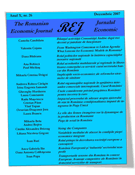Abstract:
In the following paper I intend to briefly analyze and discuss some of the major elements and influences that Romania’s integration into the European Union had on its external trade during the time frame beginning in 2002 and ending with the year that has just passed (2013). In order to achieve these goals and to emphasize certain relevant aspects of Romania’s economic changes in recent history, I want to synthetically analyze both the structure of Romania’s international trade (consisting of inflows and outflows, compared) as well as the evolution of the commercial balance of net exports versus imports, for the purpose of gaining insight into the evolution and changes that Romanian economy experienced during the aforementioned thirteen-year period. Subsequently, the 2002 – 2013 time span can be logically divided into two major periods, the one before (2002-2007) and the one after (2007-2013) Romania’s accession to the European Union, each with its own traits and peculiarities but, also, both sharing sufficient similarities between them. Therefore, my main hypothesis to be tested in the upcoming article is that the European Union integration substantially influenced (and, one could say, altered for the better) Romania’s economic outlook, and, consequently, those changes can be highlighted and quantified, among others, by a number of relevant indicators linked to the area of foreign trade, as detailed bellow.
